Some recommendations to reduce national logistics costs in Viet Nam
Giảm chi phí logistics tại Việt Nam
Tóm tắt: Logistics là một ngành dịch vụ quan trọng trong cơ cấu tổng thể của nền kinh tế quốc dân,
có vai trò hỗ trợ, kết nối và thúc đẩy phát triển kinh tế - xã hội của đất nước cũng như của từng địa
phương. Bằng việc sử dụng phương pháp phân tích và tổng hợp, bài báo nghiên cứu chi phí logistics ở
Việt Nam trong giai đoạn 2014-2020, dựa trên số liệu thu được từ các nghiên cứu trước đây và một số
báo cáo quốc tế về chi phí logistics. Theo một số báo cáo của Ngân hàng Thế giới về chi phí logistics
và Báo cáo Logistics của Bộ Công Thương (MOIT, 2020), chi phí logistics tính theo phần trăm GDP ở
Việt Nam vẫn còn cao so với nhiều nước trên thế giới. Giảm chi phí logistics trở thành giải pháp chiến
lược nhằm giảm chi phí kinh doanh và tăng khả năng cạnh tranh cho quốc gia nói chung và doanh
nghiệp nói riêng (United Nations, ESCAP, 2002); và đây là cơ sở để hoạch định các chính sách quốc gia,
phát triển và xây dựng cơ sở hạ tầng (Farahani et al. 2009, 58). Tuy nhiên, việc giảm chi phí logistics có
thể ảnh hưởng đến doanh thu của các doanh nghiệp logistics Việt Nam, do đó, bài báo đưa ra một số
giải pháp nhằm giảm chi phí logistics tại Việt Nam theo hướng nâng cao hiệu quả hoạt động logistics.
Từ khóa: chi phí, logistics, LPI, Việt Nam
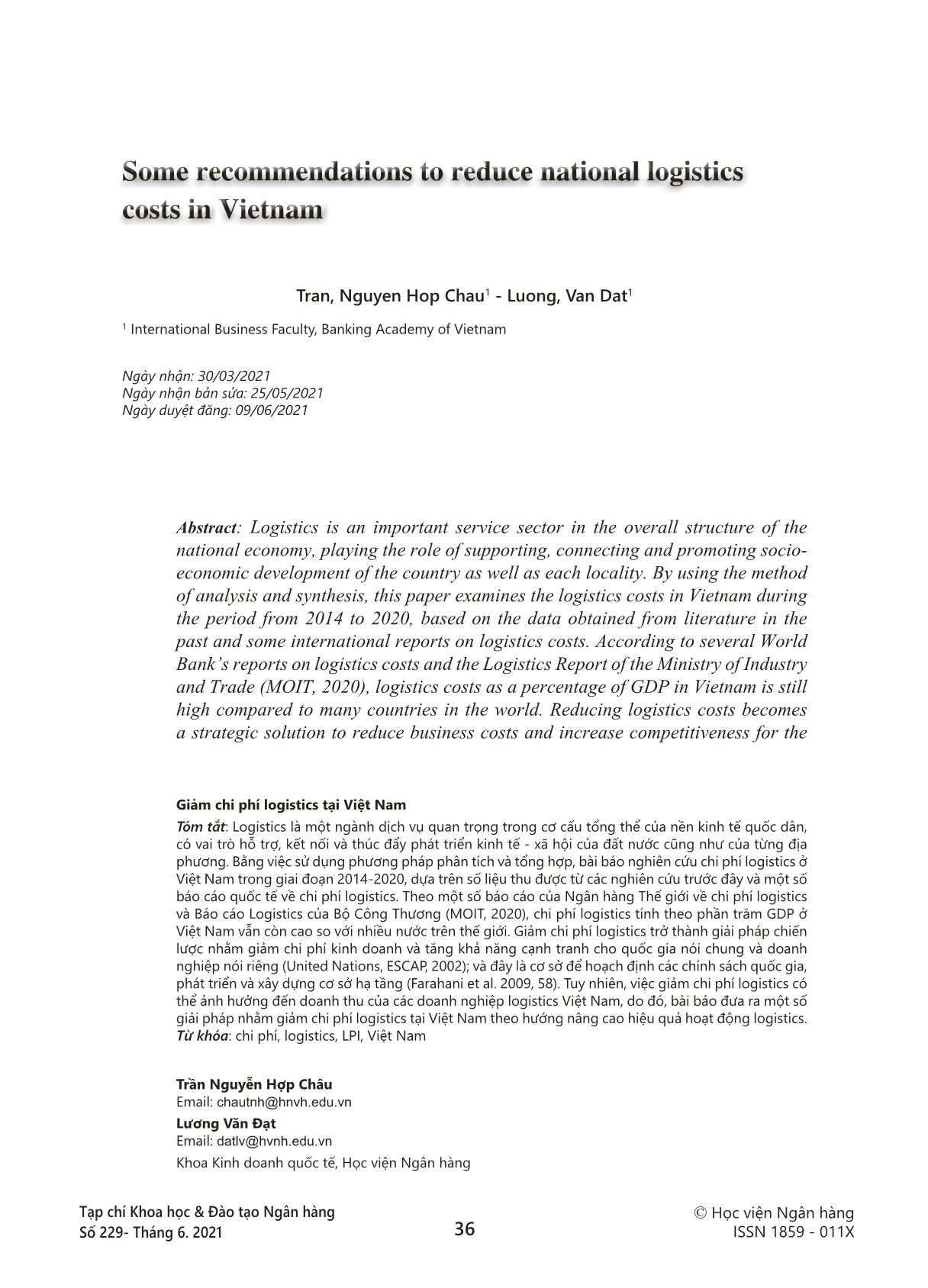
Trang 1
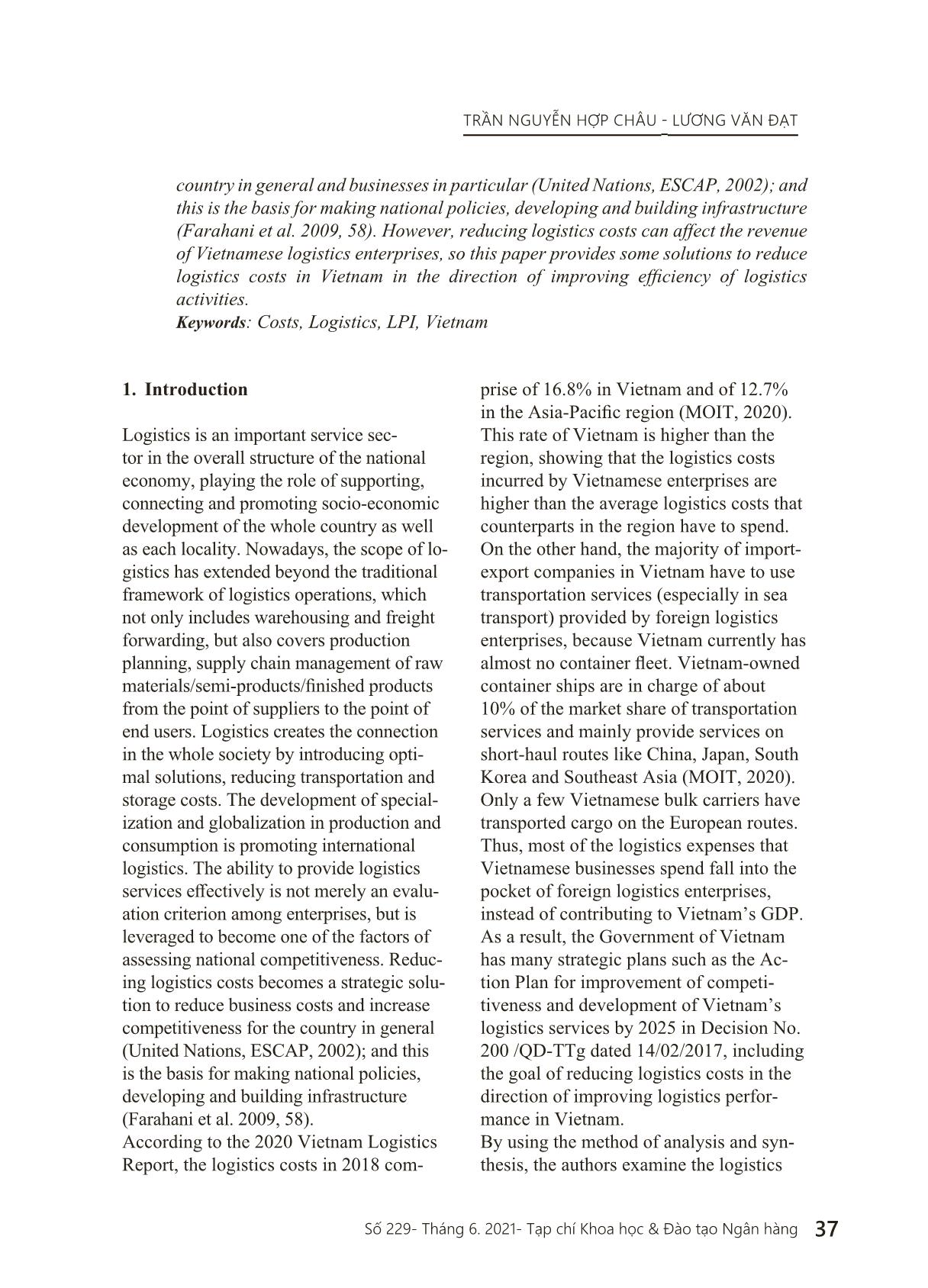
Trang 2

Trang 3

Trang 4
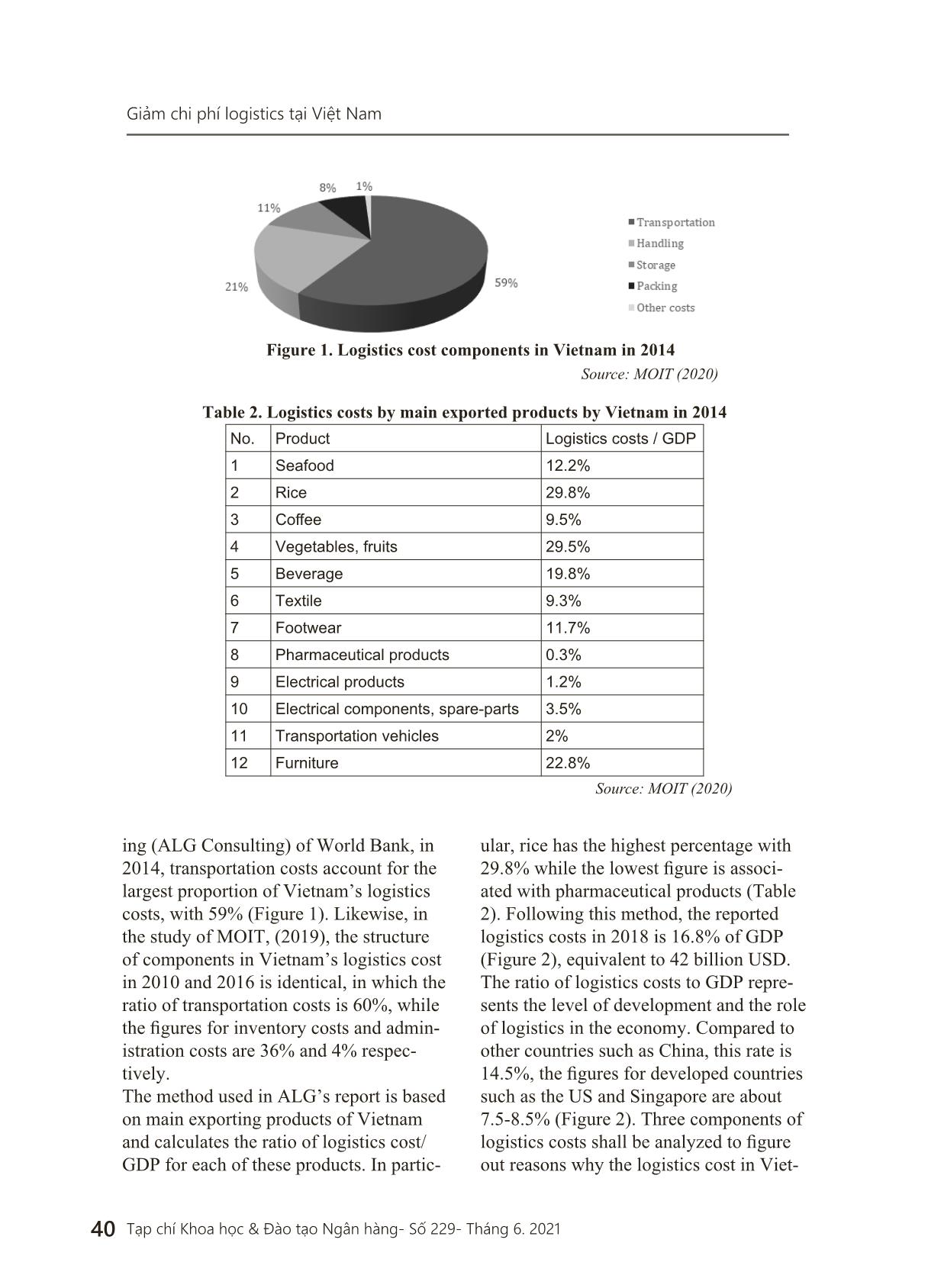
Trang 5
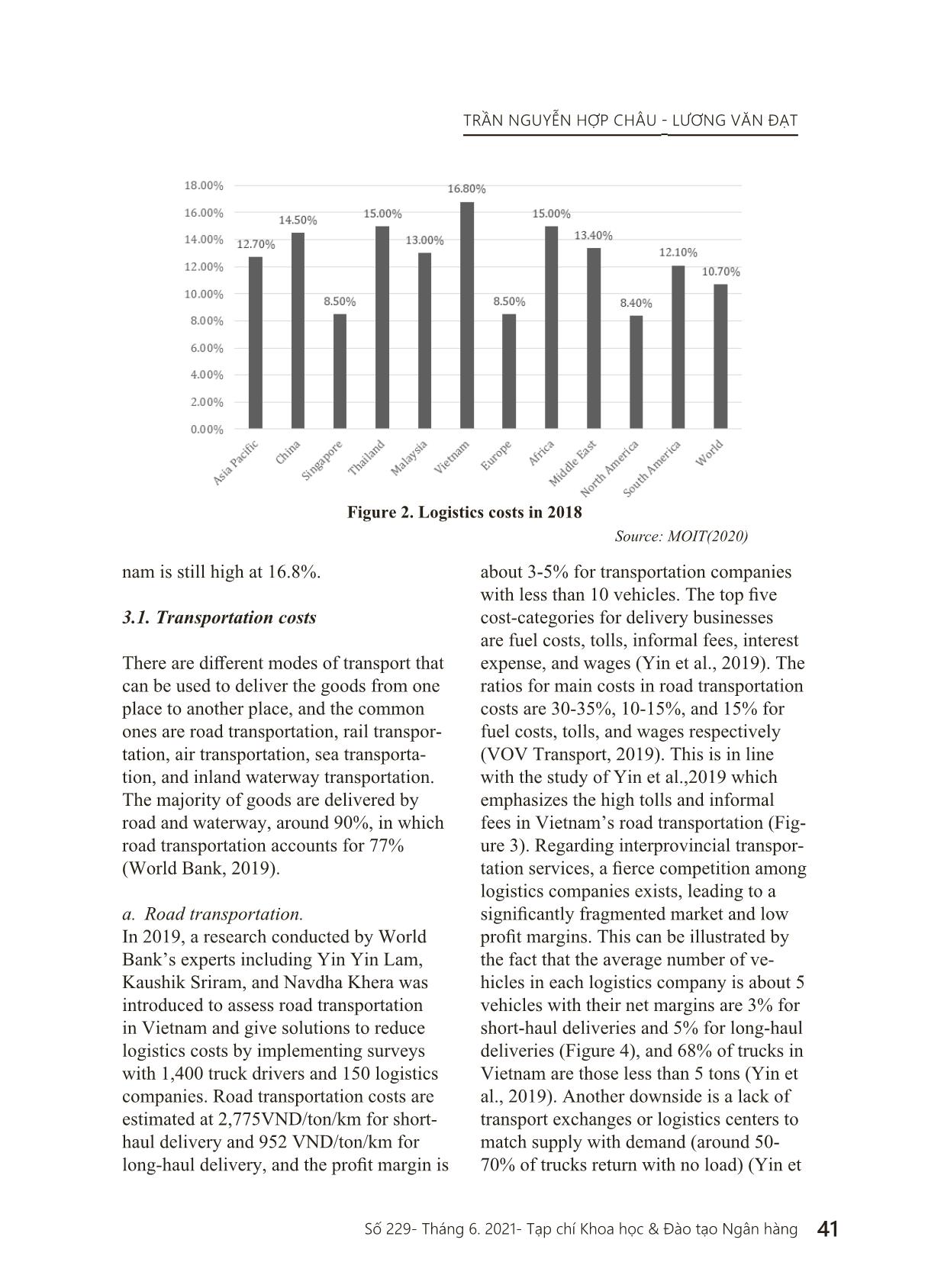
Trang 6
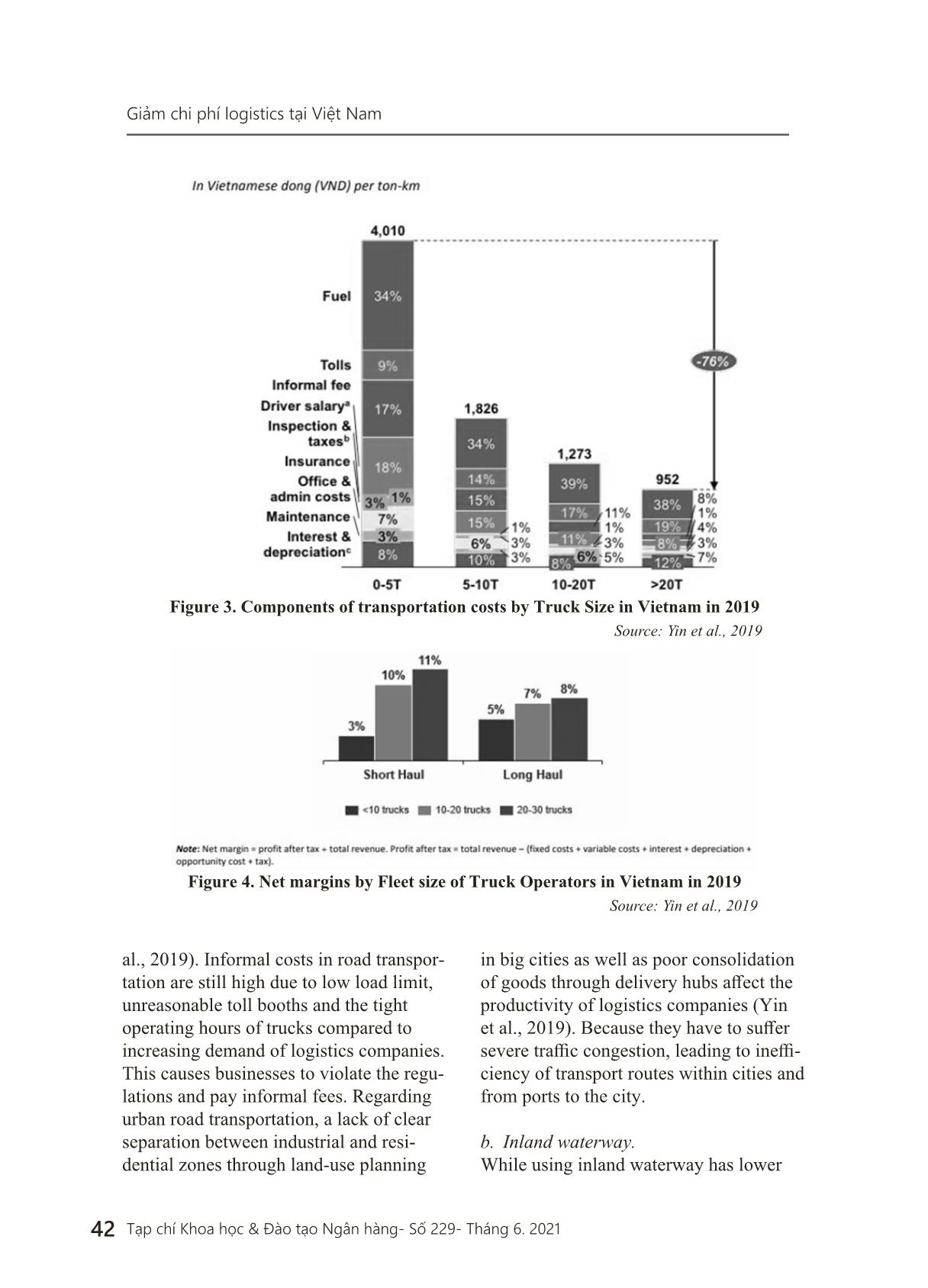
Trang 7
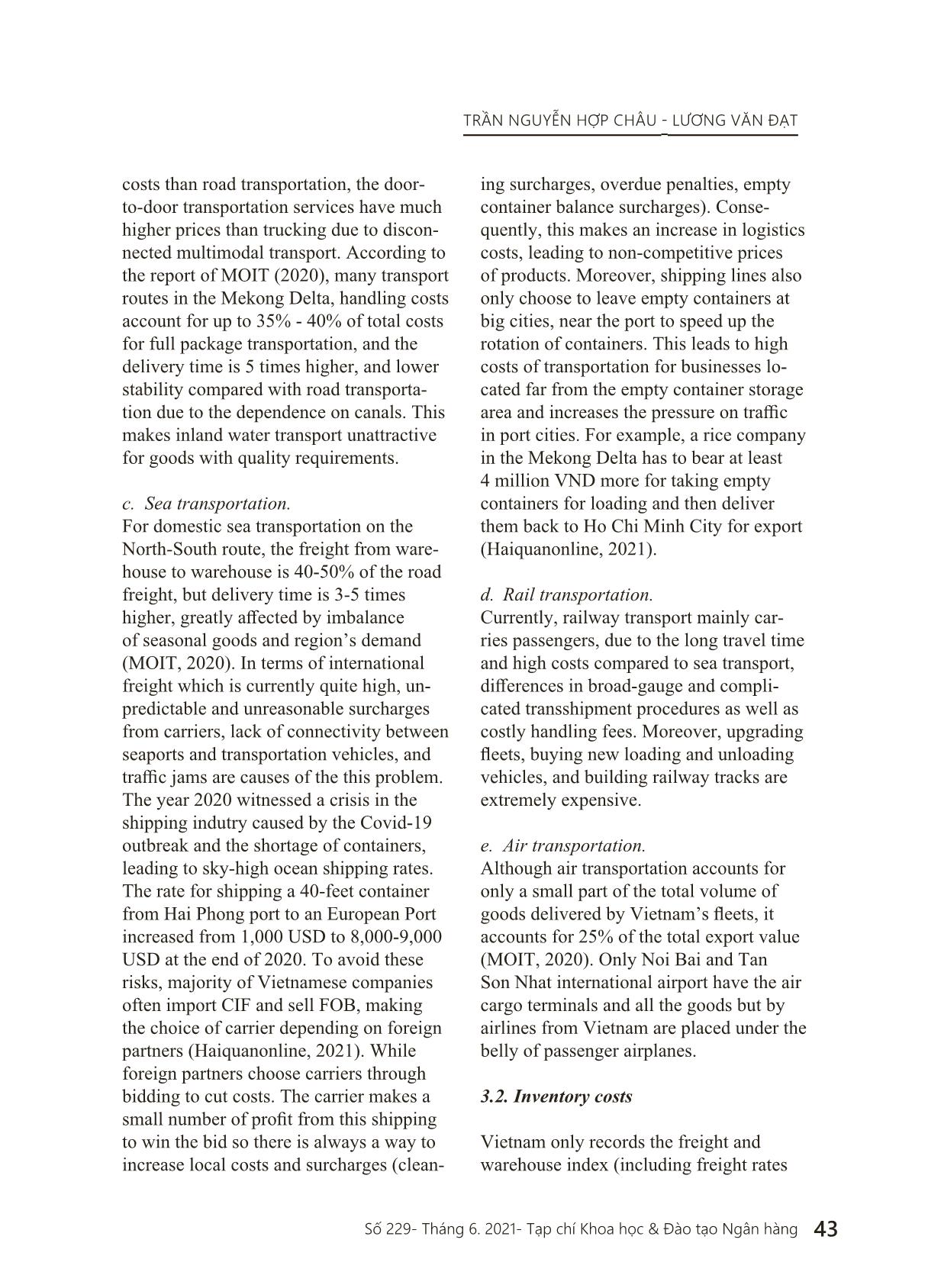
Trang 8
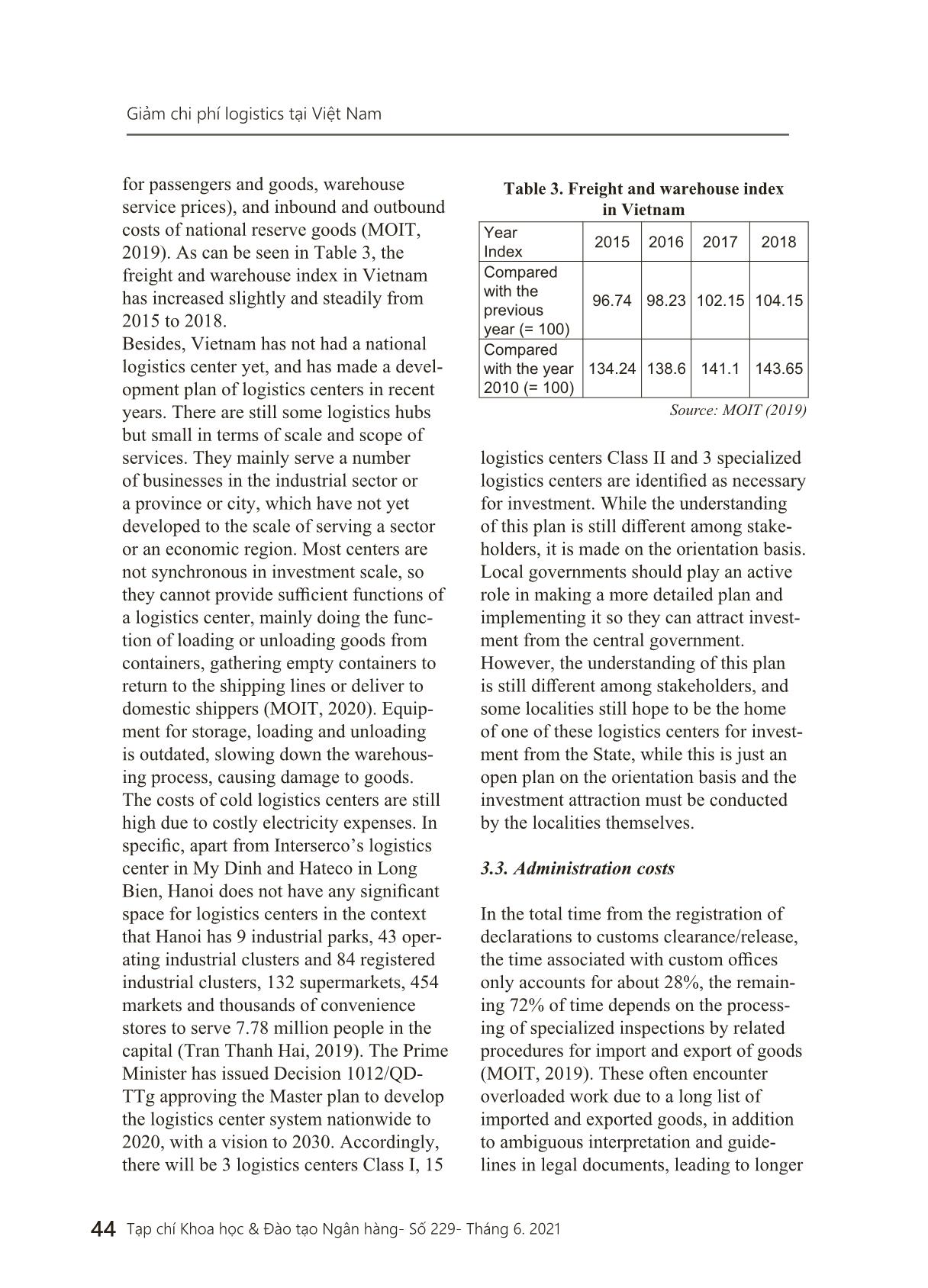
Trang 9
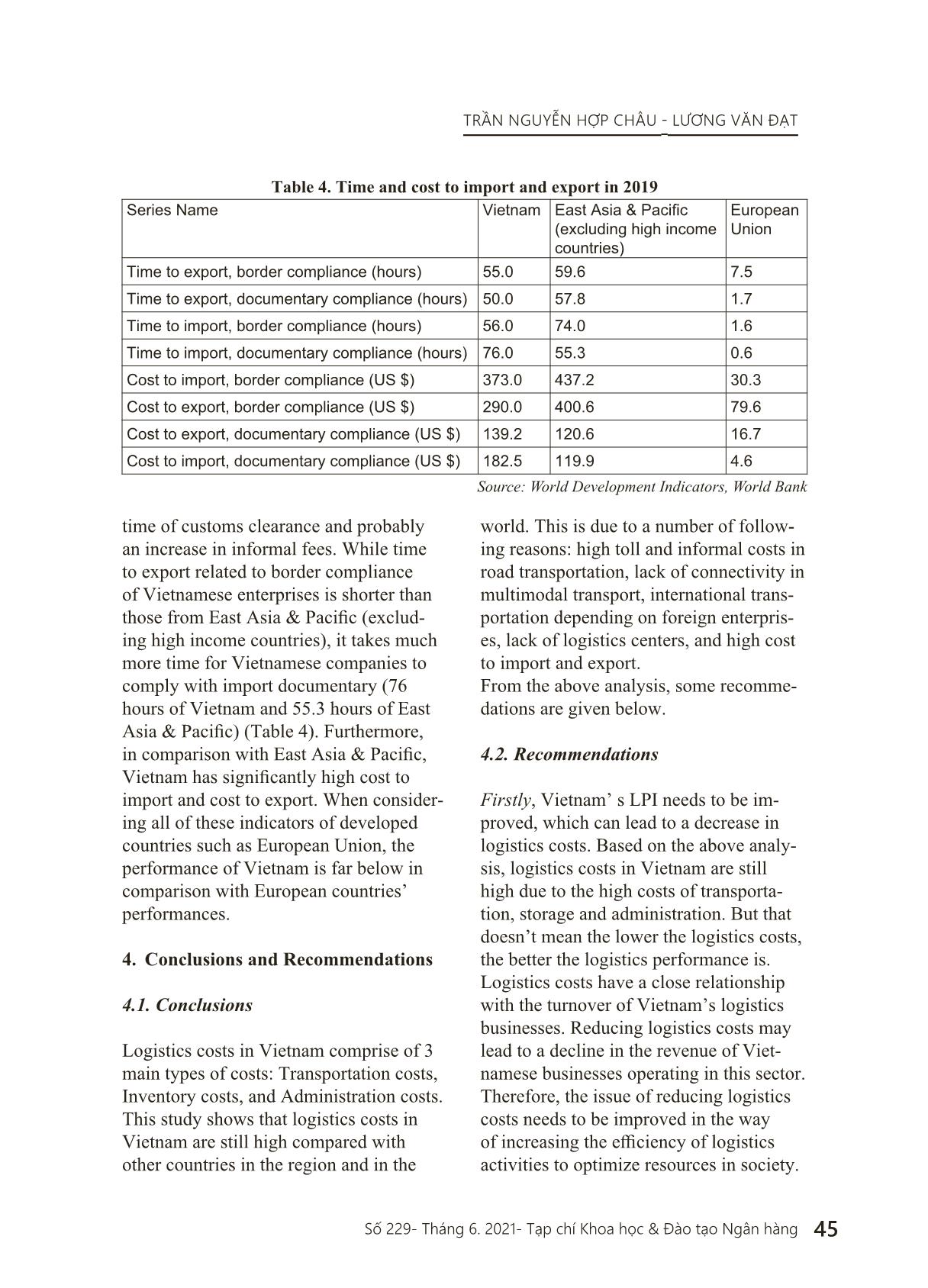
Trang 10
Tải về để xem bản đầy đủ
Tóm tắt nội dung tài liệu: Some recommendations to reduce national logistics costs in Viet Nam
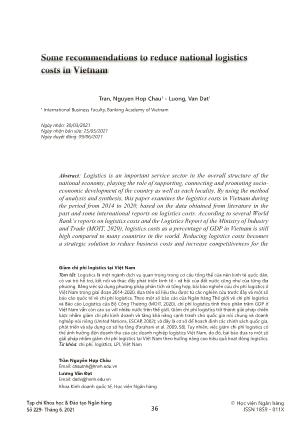
36 Tạp chí Khoa học & Đào tạo Ngân hàng Số 229- Tháng 6. 2021 © Học viện Ngân hàng ISSN 1859 - 011X Some recommendations to reduce national logistics costs in Vietnam Tran, Nguyen Hop Chau1 - Luong, Van Dat1 1 International Business Faculty, Banking Academy of Vietnam Ngày nhận: 30/03/2021 Ngày nhận bản sửa: 25/05/2021 Ngày duyệt đăng: 09/06/2021 Abstract: Logistics is an important service sector in the overall structure of the national economy, playing the role of supporting, connecting and promoting socio- economic development of the country as well as each locality. By using the method of analysis and synthesis, this paper examines the logistics costs in Vietnam during the period from 2014 to 2020, based on the data obtained from literature in the past and some international reports on logistics costs. According to several World Bank’s reports on logistics costs and the Logistics Report of the Ministry of Industry and Trade (MOIT, 2020), logistics costs as a percentage of GDP in Vietnam is still high compared to many countries in the world. Reducing logistics costs becomes a strategic solution to reduce business costs and increase competitiveness for the Giảm chi phí logistics tại Việt Nam Tóm tắt: Logistics là một ngành dịch vụ quan trọng trong cơ cấu tổng thể của nền kinh tế quốc dân, có vai trò hỗ trợ, kết nối và thúc đẩy phát triển kinh tế - xã hội của đất nước cũng như của từng địa phương. Bằng việc sử dụng phương pháp phân tích và tổng hợp, bài báo nghiên cứu chi phí logistics ở Việt Nam trong giai đoạn 2014-2020, dựa trên số liệu thu được từ các nghiên cứu trước đây và một số báo cáo quốc tế về chi phí logistics. Theo một số báo cáo của Ngân hàng Thế giới về chi phí logistics và Báo cáo Logistics của Bộ Công Thương (MOIT, 2020), chi phí logistics tính theo phần trăm GDP ở Việt Nam vẫn còn cao so với nhiều nước trên thế giới. Giảm chi phí logistics trở thành giải pháp chiến lược nhằm giảm chi phí kinh doanh và tăng khả năng cạnh tranh cho quốc gia nói chung và doanh nghiệp nói riêng (United Nations, ESCAP, 2002); và đây là cơ sở để hoạch định các chính sách quốc gia, phát triển và xây dựng cơ sở hạ tầng (Farahani et al. 2009, 58). Tuy nhiên, việc giảm chi phí logistics có thể ảnh hưởng đến doanh thu của các doanh nghiệp logistics Việt Nam, do đó, bài báo đưa ra một số giải pháp nhằm giảm chi phí logistics tại Việt Nam theo hướng nâng cao hiệu quả hoạt động logistics. Từ khóa: chi phí, logistics, LPI, Việt Nam Trần Nguyễn Hợp Châu Email: chautnh@hnvh.edu.vn Lương Văn Đạt Email: datlv@hvnh.edu.vn Khoa Kinh doanh quốc tế, Học viện Ngân hàng TRẦN NGUYỄN HỢP CHÂU - LƯƠNG VĂN ĐẠT 37Số 229- Tháng 6. 2021- Tạp chí Khoa học & Đào tạo Ngân hàng country in general and businesses in particular (United Nations, ESCAP, 2002); and this is the basis for making national policies, developing and building infrastructure (Farahani et al. 2009, 58). However, reducing logistics costs can affect the revenue of Vietnamese logistics enterprises, so this paper provides some solutions to reduce logistics costs in Vietnam in the direction of improving efficiency of logistics activities. Keywords: Costs, Logistics, LPI, Vietnam 1. Introduction Logistics is an important service sec- tor in the overall structure of the national economy, playing the role of supporting, connecting and promoting socio-economic development of the whole country as well as each locality. Nowadays, the scope of lo- gistics has extended beyond the traditional framework of logistics operations, which not only includes warehousing and freight forwarding, but also covers production planning, supply chain management of raw materials/semi-products/finished products from the point of suppliers to the point of end users. Logistics creates the connection in the whole society by introducing opti- mal solutions, reducing transportation and storage costs. The development of special- ization and globalization in production and consumption is promoting international logistics. The ability to provide logistics services effectively is not merely an evalu- ation criterion among enterprises, but is leveraged to become one of the factors of assessing national competitiveness. Reduc- ing logistics costs becomes a strategic solu- tion to reduce business costs and increase competitiveness for the country in general (United Nations, ESCAP, 2002); and this is the basis for making national policies, developing and building infrastructure (Farahani et al. 2009, 58). According to the 2020 Vietnam Logistics Report, the logistics costs in 2018 com- prise of 16.8% in Vietnam and of 12.7% in the Asia-Pacific region (MOIT, 2020). This rate of Vietnam is higher than the region, showing that the logistics costs incurred by Vietnamese enterprises are higher than the average logistics costs that counterparts in the region have to spend. ... o Ngân hàng time of customs clearance and probably an increase in informal fees. While time to export related to border compliance of Vietnamese enterprises is shorter than those from East Asia & Pacific (exclud- ing high income countries), it takes much more time for Vietnamese companies to comply with import documentary (76 hours of Vietnam and 55.3 hours of East Asia & Pacific) (Table 4). Furthermore, in comparison with East Asia & Pacific, Vietnam has significantly high cost to import and cost to export. When consider- ing all of these indicators of developed countries such as European Union, the performance of Vietnam is far below in comparison with European countries’ performances. 4. Conclusions and Recommendations 4.1. Conclusions Logistics costs in Vietnam comprise of 3 main types of costs: Transportation costs, Inventory costs, and Administration costs. This study shows that logistics costs in Vietnam are still high compared with other countries in the region and in the world. This is due to a number of follow- ing reasons: high toll and informal costs in road transportation, lack of connectivity in multimodal transport, international trans- portation depending on foreign enterpris- es, lack of logistics centers, and high cost to import and export. From the above analysis, some recomme- dations are given below. 4.2. Recommendations Firstly, Vietnam’ s LPI needs to be im- proved, which can lead to a decrease in logistics costs. Based on the above analy- sis, logistics costs in Vietnam are still high due to the high costs of transporta- tion, storage and administration. But that doesn’t mean the lower the logistics costs, the better the logistics performance is. Logistics costs have a close relationship with the turnover of Vietnam’s logistics businesses. Reducing logistics costs may lead to a decline in the revenue of Viet- namese businesses operating in this sector. Therefore, the issue of reducing logistics costs needs to be improved in the way of increasing the efficiency of logistics activities to optimize resources in society. Table 4. Time and cost to import and export in 2019 Series Name Vietnam East Asia & Pacific (excluding high income countries) European Union Time to export, border compliance (hours) 55.0 59.6 7.5 Time to export, documentary compliance (hours) 50.0 57.8 1.7 Time to import, border compliance (hours) 56.0 74.0 1.6 Time to import, documentary compliance (hours) 76.0 55.3 0.6 Cost to import, border compliance (US $) 373.0 437.2 30.3 Cost to export, border compliance (US $) 290.0 400.6 79.6 Cost to export, documentary compliance (US $) 139.2 120.6 16.7 Cost to import, documentary compliance (US $) 182.5 119.9 4.6 Source: World Development Indicators, World Bank Giảm chi phí logistics tại Việt Nam 46 Tạp chí Khoa học & Đào tạo Ngân hàng- Số 229- Tháng 6. 2021 Currently, the performance of logistics op- erations is often assessed by the logistics performance index (LPI). This is an index given by the World Bank to rank the effi- ciency and capacity of logistics operations of countries. This index is published every two years. There have been 6 LPI rat- ings in 2007, 2010, 2012, 2014, 2016 and 2018. Although it is just an index given by an organization, the World Bank’s LPI has been recognized by a large number of countries as a reliable indicator evaluating the performance of the logistics service industry in each country. The LPI indexes have six components (Figure 5): - The efficiency of customs and border management clearance. - The quality of trade and transport infra- structure. - The ease of arranging competitively priced shipments. - The competence and quality of logistics services. - The ability to track and trace consign- ments. The frequency with which shipments reach consignees within scheduled or ex- pected delivery times. According to Karri Rantasila and Lauri Ojala (2012), there is a relationship be- tween a country’s LPI ranking and its level of logistics costs: countries with a low LPI score tend to have high costs. In particular, induced costs (related to non- delivery or the avoidance of non-delivery and storage) tend to be low in countries with a high LPI score, and direct costs (freight and other shipment-related costs) tend to decrease until the LPI score reach- es a value of around 3.3 (Figure 6). Figure 5. Input and Outcome LPI Indicators Source: WTO, 2012 Figure 6. The Relationship between the LPI and the Level of Logistics Costs Source: Arvis, Mustra, Panzer, Ojala & Naula (2007) TRẦN NGUYỄN HỢP CHÂU - LƯƠNG VĂN ĐẠT 47Số 229- Tháng 6. 2021- Tạp chí Khoa học & Đào tạo Ngân hàng LPI of Vietnam has been improved through years, from 2.89 in 2007 rising to 3.27 in 2018. Especially, Vietnam’s global ranking jumped from 64th in 2016 to 39th in 2018. Among the lower-middle-income economies, Vietnam led the global rank- ings in 2018 followed by India, Indonesia, Côte d’Ivoire, Philippines, and Ukraine (Koushan Das, 2018). However, in com- parison with developed countries, Viet- nam’s logistics performance is far below (Figure 7). Thus, in order to reduce logistics costs in the direction of improving logistics ef- ficiency, it is necessary to pay attention to improve LPI. The improvement of LPI can be achieved by improving LPI components such as reforming customs procedures, improving the quality of infra- structure, utilizing advanced information technologies... Secondly, Vietnamese companies should get the right to transport goods interna- tionally by negotiating proper Incoterms. In the study of Pohlen, T. Klammer, T. Cokins, G. (2009), the application of inter- national commercial terms (Incoterms) is closely related to logistics costs. One way of identifying the company’s share of the costs is to scrutinize the terms of deliv- ery. For example, if a company purchases its raw material Ex-Works (EXW) and delivers its products duty paid (DDP), it may seem to incur higher logistics costs than a company that arranges its deliveries differently. But on the positive side, busi- nesses will buy goods with the cheapest price and sell goods with the highest price. Vietnamese enterprises should choose the commercial terms in which they have the right to charter transportation vehicles. In international transactions, businesses should build strategic relationships with a number of shipping lines, and take the initiative in negotiating with partners on chartering rights. As a result, there is a basis to negotiate with a foreign partner to win the right to transport, thereby control- ling shipping costs and avoiding pressure of high freight costs. The third recommendation is that there is a strong need for Vietnam’s logistics enterprises to coordinate and support each other to implement full logistics services in a supply chain to improve efficiency and reduce costs for logistics operations. Currently, Vietnam has more than 3,000 enterprises registered to operate in the Figure 7. Logistics performance index Source: World Development Indicators, World Bank Giảm chi phí logistics tại Việt Nam 48 Tạp chí Khoa học & Đào tạo Ngân hàng- Số 229- Tháng 6. 2021 logistics sector, of which 89% are domes- tic enterprises, 10% are joint ventures, and 1% are foreign enterprises. Domestic enterprises are mostly small and only ac- count for about 20% of the total market revenue (Cao Cam Linh, 2021). Domestics logistics companies only provide frag- mented logistics services in the territory of Vietnam such as forwarding services, packaging services, warehouse rental, customs services... At the same time, there is a lack of synchronous linkage between logistics businesses participating in the whole supply chain. Meanwhile, integrat- ed and international intermodal services are provided by foreign owned enterprises. Therefore, the Vietnamese government should have a strategic plan to coordi- nate logistics activities of Vietnamese companies in an integrated supply chain to improve performance of the logistics industry. Fourthly, applying information technolo- gies to logistics activities is an inevitable trend, advanced technologies in manage- ment and administration should be used in all stages of supply chains, including logistics activities. Logistics infrastructure systems include physical infrastructure such as transportation systems, wharf... and soft infrastructure such as human resources, system of policies and laws, procedures... These systems cannot be controlled and managed effectively and efficiently unless information technologies are integrated and applied in the systems. The ability of container ships to load or unload cargo quickly or slowly depends heavily on the technology used by ship- owners and port operators in their man- agement. Technology can help shipowners plan the whole process, how to load and unload goods, moving goods to or from the yard, even how to load containers in an optimal way. Meanwhile, port authorities rely on technology to monitor the safety of the waters and process paperwork so that ships can get in and out of ports effectively and in a timely manner. 4.3. Limitations and Future research In some parts of the paper, the data has not been up-to-dated. This is because the fact that data on logistics costs in Vietnam has not been official collected and there are no authoritative agencies responsible for doing this. Moreover, secondary data, e.g. World Bank’s data on logistics costs, are publicized every 2 years, and the lat- est available data is investigated in 2018. There is an immediate and urgent need for research in the future on the method to calculate the logistics costs in Vietnam, and the results should be evaluated and audited before and after the time when the project is conducted. This should be an important and reliable source to inform governments and private sectors in the process of decision-making ■ References Arvis, JF., Mustra, A., Panzer, J., Ojala, L., Naula, T. 2007. Connecting to Compete 2007: Trade Logistics in the Global Economy. The Logistics Performance Index and Its Indicators. Washington DC. Cao Cam Linh. 2021. Phát triển dịch vụ logistics ở Việt Nam trong bối cảnh kinh tế số. Accessed: 29 March 2021, at <https://tapchitaichinh.vn/tai-chinh-kinh-doanh/phat-trien-dich-vu-logistics-o-viet-nam-trong-boi-canh-kinh-te- so-331297.html> The Prime Minister of Vietnam (2015), Decision No. 1012 /QD-TTg dated 03/07/2015, approval for nationwide logistics center system development planning by 2020 and orientation towards 2030 The Prime Minister of Vietnam (2017), Decision No. 200 /QD-TTg dated 14/02/2017, approval for the action plan for improvement of competitiveness and development of Vietnam’s logistics services by 2025 TRẦN NGUYỄN HỢP CHÂU - LƯƠNG VĂN ĐẠT 49Số 229- Tháng 6. 2021- Tạp chí Khoa học & Đào tạo Ngân hàng Farahani, RZ., Asgari, N., Davarzani, H. 2009. Supply Chain and Logistics in National, International and Governmental Environment - Concepts and Models. Physiga-Verlag, Berlin, Germany. Haiquanonline, 2021. Kéo giảm chi phí cho hàng hóa xuất nhập khẩu - Cần làm ngay - Bài 1: Phí chính, phí phụ đội giá hàng Việt. Accessed: 19 May 2021, at <https://haiquanonline.com.vn/keo-giam-chi-phi-cho-hang-hoa-xuat- nhap-khau-can-lam-ngay-bai-1-phi-chinh-phi-phu-doi-gia-hang-viet-144379.html> International Chamber of Commerce, Incoterms® 2020 Karri Rantasila and Lauri Ojala, 2012. Measurement of National-Level Logistics Costs and Performance. International Transport Forum Discussion Papers. [International Transport Forum Discussion Papers] https:// doi.org/10.1787/5k8zvv79pzkk-en. Koushan Das, 2018. Vietnam Climbs 25 Places in World Bank’s Logistics Index - Vietnam Briefing News. [online] Available at: <https://www.vietnam-briefing.com/news/vietnam-climbs-25-places-world-banks-logistics-index. html/> [Accessed 27 Mar. 2021]. Ministry of Transport. 2014. Hội thảo Hoàn thiện và công bố Báo cáo cuối kỳ “Hỗ trợ kỹ thuật về vận tải đa phương thức cho Bộ GTVT. Accessed: 29 March 2021, at< bo-bao-cao-cuoi-ky-%E2%80%9Cho-tro-ky-thuat-ve-van-tai-da-phuong-thuc-cho-bo-gtvt%E2%80%9D.aspx> MOIT, 2019. Nghiên cứu, đề xuất giải pháp nhằm giảm chi phí logistics Việt Nam. MOIT, 2020. Vietnam Logistics Report 2020. Pohlen, T., Klammer, T., Cokins, G. 2009. The Handbook of Supply Chain Costing. Lombard, Illinois, USA Resolution No.18/NQ-CP. 2020. Accessed: 19 May 2021, at <https://thuvienphapluat.vn/van-ban/Doanh-nghiep/ Nghi-quyet-18-NQ-CP-2020-sua-doi-Nghi-quyet-97-NQ-CP-co-cau-lai-doi-moi-doanh-nghiep-nha-nuoc-435673. aspx> Thoi bao Tai Chinh Viet Nam. 2021. Phát triển doanh nghiệp nhà nước quy mô lớn: Áp dụng nguyên tắc “cây gậy và củ cà rốt” trong hỗ trợ. Accessed: 19 May 2021, at < doanh/2021-03-29/phat-trien-doanh-nghiep-nha-nuoc-quy-mo-lon-ap-dung-nguyen-tac-cay-gay-va-cu-ca-rot- trong-ho-tro-101687.aspx> Tran Thanh Hai. 2019. Trung tâm logistics không chỉ là cái kho!. Accessed: 19 May 2021, at < https://www. thesaigontimes.vn/292769/Trung-tam-logistics-khong-chi-la-cai-kho!.html> United Nations, ESCAP ed., 2002. Commercial development of regional ports as logistics centres. New York: United Nations. VOV Transport, 2019. Chi phí logistics Việt Nam tương đương 16 - 17% GDP. Accessed: 29 March 2021, at <https:// www.thesaigontimes.vn/281775/a.html> World Bank, 2019. Dissemination Workshop on Sustainable Development of Inland Waterways Transport in Vietnam and Strengthening Vietnam’s Trucking Sector. [Text/HTML] World Bank. Available at: <https://www.worldbank. org/en/news/speech/2019/04/05/dissemination-workshop-on-sustainable-development-of-inland-waterways- transport-in-vietnam-and-strengthening-vietnams-trucking-sector> [Accessed 27 Mar. 2021]. World Development Indicators. World Bank Data. Accessed: 29 March 2021, at <https://databank.worldbank.org/ home.aspx> WTO. 2012. Connecting to Compete-Trade Logistics in the Global Economy, The Logistics Performance Index and Its Indicators. Washington DC. Yin Yin Lam, Kaushik Sriram, and Navdha Khera. 2019. Tăng cường ngành Vận tải hàng hóa đường bộ Việt Nam, Hướng đến giảm Chi phí Logistics và Phát thải khí nhà kính. Accessed: 29 March 2021, at< worldbank.org/curated/en/804331554202696143/pdf/T%c4%83ng-c%c6%b0%e1%bb%9dng-ng%c3%a0nh- V%e1%ba%adn-t%e1%ba%a3i-h%c3%a0ng-h%c3%b3a-%c4%91%c6%b0%e1%bb%9dng-b%e1%bb%99- Vi%e1%bb%87t-Nam-H%c6%b0%e1%bb%9bng-%c4%91%e1%ba%bfn-gi%e1%ba%a3m-Chi-ph%c3%ad- Logistics-v%c3%a0-Ph%c3%a1t-th%e1%ba%a3i-kh%c3%ad-nh%c3%a0-k%c3%adnh.pdf>
File đính kèm:
 some_recommendations_to_reduce_national_logistics_costs_in_v.pdf
some_recommendations_to_reduce_national_logistics_costs_in_v.pdf

